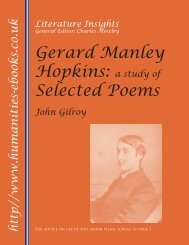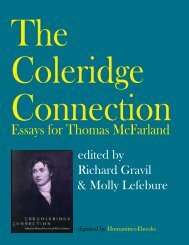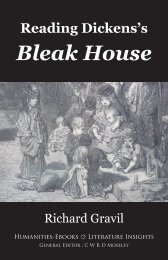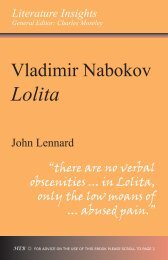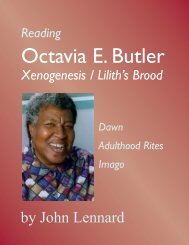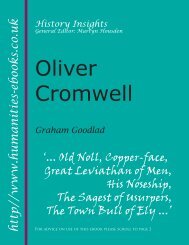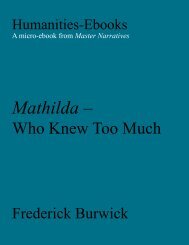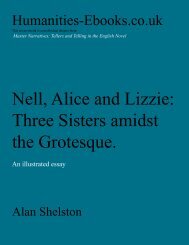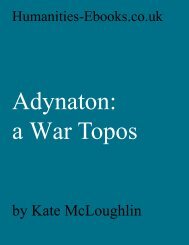On Beulah Height - Humanities-Ebooks
On Beulah Height - Humanities-Ebooks
On Beulah Height - Humanities-Ebooks
Create successful ePaper yourself
Turn your PDF publications into a flip-book with our unique Google optimized e-Paper software.
heroic, hopeless task). Wield started as necessary underling, a replacement Detective<br />
Sergeant when Pascoe made Inspector, but in coming to terms with his identity as a<br />
gay policeman (and latterly finding contentment with Digweed) has grown into<br />
close personal friendship with the Pascoes.<br />
Some minor characters have also become established presences— solicitor Eden<br />
Thackeray, vicar Larry Lillingstone in Enscombe, idiotic and disaster-prone PC<br />
Hector—but these are tagged or re-explained when they recur.<br />
1.2.3 Mid-Yorkshire and Northern English Speech<br />
All Hill’s D.-&-P. novels are set in the fictional, archetypal ‘Mid-Yorkshire’ (Mid-<br />
Yorks.), an additional imaginary administrative county drawing freely on the land-<br />
and cityscapes of the whole of Yorkshire. Detailed settings—villages like Dendale<br />
and Enscombe—are fictional; real place-names are rarely given, but the industrial<br />
cities of Sheffield and Doncaster (where Hill lived), and the cathedral-city of York,<br />
are often recognisable, as are features of landscape, economy, and demography.<br />
Mid-Yorks., that is, is an archetype, like Hardy’s Wessex or Paul Scott’s Ranpur and<br />
Mirat a blend of typicalities and fictions making a place utterly grounded in the real,<br />
but never restricted to it, or to real-world geography. To understand it, therefore, one<br />
has to know something of the Yorkshire that provides Hill with his raw materials.<br />
A very large traditional county in Northern England, Yorkshire stretches from<br />
Sheffield to Middlesbrough and the Pennines to the East Coast. It covers some 6,000<br />
square miles (15,000 km 2 ), and has a population of roughly 5 million. (See <br />
http://www.yorkshirenet.co.uk/maps/index.asp.) Yorkshire is traditionally divided<br />
into the North, West, and East ‘Ridings’ (or ‘thirds’), reflecting the Vikings’<br />
division of land around the cathedral city of York.<br />
Much of the North Riding is uneven rural land, the Yorkshire Dales in the east<br />
and North York Moors in the west. A ‘dale’ is a valley; most are farmed both for<br />
arable and dairy produce, and they are flanked by ‘fells’, hills used for sheepfarming.<br />
The moors, often boggy, are high and desolate. Administratively the North<br />
Riding is now mostly the county of North Yorkshire.<br />
The East Riding is low farmland, some higher ground (the Yorkshire Wolds),<br />
and a fishing coast, with Hull the only big city. It is still known as the East Riding,<br />
and most is administratively its own county.<br />
The West Riding has been very heavily urbanised and industrialised since the<br />
early nineteenth century, but service and light industries now predominate. The<br />
major cities of Leeds, Bradford, Halifax, Huddersfield, Doncaster (where Hill lived<br />
10



